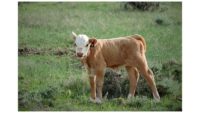In drought, watch fall-calving cows early, says MU vet

Owners of fall-calving cow herds should start watching early as calving time approaches, says a University of Missouri veterinarian. Drought stress and high nitrate levels in a cow’s forage ration can trigger early calving, stillbirths and abortions.
“Nitrates may be causing itty-bitty calves,” says Tim Evans of the MU Veterinary Diagnostic Lab, Columbia.
Evans wants the word out, he says, even though there have been many alerts about dangers of nitrates in drought-stricken feeds, particularly cornstalks, sorghum-sudangrass, millet and even fescue pastures. While many crop-and-cow farmers may recognize nitrate dangers, those who have not seen a drought this severe or are part-time farmers may not know the dangers, Evans says.
“We received a sample of millet hay that was just off the charts,” Evans says of samples submitted for nitrate testing. “Test results vary widely, from less than 100 parts per million to over 30,000 for the millet.” The latter was twice the level considered toxic.
Forages with less than 2,500 ppm nitrates are considered safe to use. “But I don’t know what you could do with the toxic millet,” Evans says.
While cows can die from eating high-nitrate rations, the unseen economic impact will come from lost calves. Nitrates can cause premature births and abortions as the oxygen supply to the fetus is reduced.
“Cows in late gestation are at high risk,” Evans says. “The unborn calf depends on oxygen in the mother’s blood flow. Such stress can trigger labor.”
In the cow’s rumen, where forage digests, nitrates can convert to nitrites, which are deadly. Nitrites change hemoglobin that normally carries oxygen. The color of blood turns from red to chocolate brown as the blood cells take on toxic nitrites. Hypoxia, a shortage of blood oxygen, might kill a fetus but show mild symptoms, such as lethargy, in the cow.
“When blood oxygen drops, that starts a cascade of events leading to parturition,” Evans says. In earlier stages of pregnancy, that stress leads to abortion or stillbirth. Later, premature births may result in tiny calves that need extra care to survive.
At higher risk are anemic cows. “When you stack stresses, the risk of loss increases,” Evans says.
The main point, Evans says: “You won’t know the nitrate content in forage unless you test.” A test is a small investment to prevent loss of cow or calf.
Evans recommended testing forages going into silos or plastic bags. Now he urges testing silage coming out, before feeding.
The ensiling process can reduce nitrate content 25 to 50 percent. Reduction depends on effectiveness of the ensiling process and on how long the process is allowed to work.
“Sixty days is safer, but 45 days is iffy,” Evan says. “Again, the only way to know is to test.”
A good many forage samples have tested 10,000 ppm, in the “danger” zone. If ensiling reduces nitrates to below 5,000 ppm, the “caution” level, the producer will need nitrate-free forages to mix in the ration to dilute toxicity. A nitrate level above 2,500 ppm should not be fed to pregnant cows or very young calves. Nonreproductive cattle, including steers, can be fed higher levels.
Any forage with more than 15,000 ppm nitrates should not be fed under any circumstance, he warns.
The rumen can adapt to higher levels of nitrates. However, that takes a gradual buildup as rumen microbes adapt to high-nitrate feeds.
A guide on safe use of toxic forages was written by Evans with Rob Kallenbach, MU Extension forage specialist. The guide is available online at vmdl.missouri.edu. Click on “Nitrate Facts” in the right column. Details on samples and testing are listed there.
Source: University of Missouri
Looking for a reprint of this article?
From high-res PDFs to custom plaques, order your copy today!




.png?height=200&t=1666376187&width=200)
